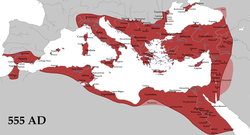Eastern Empire
| Byzantine Empire | ||||||||||
|
Βασιλεία Ῥωμαίων Basileía Rhōmaíōn Imperium Romanum |
||||||||||
|
||||||||||
|
|
||||||||||
| Capital | Constantinople | |||||||||
| Languages | ||||||||||
| Religion |
Christianity(Eastern Orthodox) (tolerated after the Edict of Milan in 313; state religion after 380) |
|||||||||
| Government | monarchy | |||||||||
| Notable emperors | ||||||||||
| • | c. 330–337 | Constantine I | ||||||||
| • | 457–474 | Leo I | ||||||||
| • | 527–565 | Justinian I | ||||||||
| • | 610–641 | Heraclius | ||||||||
| • | 976–1025 | Basil II | ||||||||
| • | 1081–1118 | Alexius I | ||||||||
| • | 1259–1282 | Michael VIII | ||||||||
| • | 1449–1453 | Constantine XI | ||||||||
| Historical era | Late Antiquity to Late Middle Ages | |||||||||
| • | Partition of the Roman Empire | 285 | ||||||||
| • | Founding of Constantinople | 330 | ||||||||
| • | Death of Theodosius I | 395 | ||||||||
| • | Nominal end of the Western Roman Empire | 476 | ||||||||
| • | Fourth Crusade | 1204 | ||||||||
| • | Reconquest of Constantinople | 1261 | ||||||||
| • | Fall of Constantinople | 29 May 1453 | ||||||||
| • | Fall of Trebizond | 15 August 1461 | ||||||||
| • | Fall of Principality of Theodoro | December 1475 | ||||||||
| Area | ||||||||||
| • | 450 AD | 2,800,000 km² (1,081,086 sq mi) | ||||||||
| • | 555 AD | 2,700,000 km² (1,042,476 sq mi) | ||||||||
| Population | ||||||||||
| • | 565 AD est. | 26,000,000 | ||||||||
| • | 780 AD est. | 7,000,000 | ||||||||
| • | 1025 AD est. | 12,000,000 | ||||||||
| Currency | Solidus, Hyperpyron and Follis | |||||||||
|
||||||||||
| a. | ^ Βασιλεία Ῥωμαίων may be transliterated in Latin as Basileia Rhōmaiōn, meaning Roman Empire. | |||||||||
| b. | ^ Between 1204 and 1261 there was an interregnum when the Empire was divided into the Empire of Nicaea, the Empire of Trebizond and the Despotate of Epirus, which were all contenders for rule of the Empire. The Empire of Nicaea is considered the legitimate continuation of the Byzantine Empire because they managed to re-take Constantinople. | |||||||||
| c. | ^ See Population of the Byzantine Empire for more detailed figures taken provided by McEvedy and Jones, Atlas of World Population History, 1978, as well as Angeliki E. Laiou, The Economic History of Byzantium, 2002. | |||||||||

Tremissis with the image of Justinian the Great
(r. 527–565) (see Byzantine insignia)
The Byzantine Empire, also referred to as the Eastern Roman Empire, was the continuation of the Roman Empire in the East during Late Antiquity and the Middle Ages, when its capital city was Constantinople (modern-day Istanbul, which had been founded as Byzantium). It survived the fragmentation and fall of the Western Roman Empire in the 5th century AD and continued to exist for an additional thousand years until it fell to the Ottoman Turks in 1453. During most of its existence, the empire was the most powerful economic, cultural, and military force in Europe. Both "Byzantine Empire" and "Eastern Roman Empire" are historiographical terms created after the end of the realm; its citizens continued to refer to their empire as the Roman Empire (Greek: Βασιλεία τῶν Ῥωμαίων, tr. Basileia tôn Rhōmaiōn; Latin: Imperium Romanum), or Romania (Ῥωμανία), and to themselves as "Romans".
...
Wikipedia

